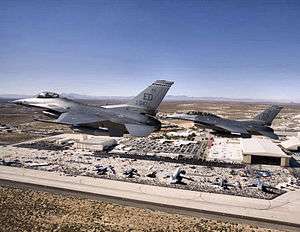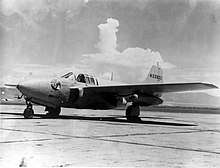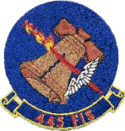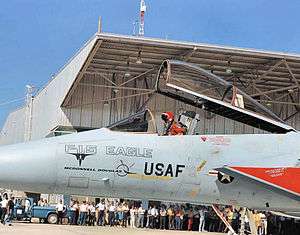445th Flight Test Squadron
The 445th Flight Test Squadron (445 FLTS) was a United States Air Force squadron. It was last assigned to the 412th Operations Group, Air Force Materiel Command, stationed at Edwards Air Force Base, California.
| 445th Flight Test Squadron | |
|---|---|
 F-16C 85-1547 & F-16D 90-0797 from the 445th FLTS at Edwards Air Force Base Flight Test Nation 17 October 2009
6512th Test Squadron McDonnell Douglas F-15A Eagle 71-0280, first F-15 manufactured, preparing to make its first flight on 27 July 1972 | |
| Active | 24 February 1943 – 3 July 1946 20 March 1953 – 30 September 1968 1 October 1969 – 20 November 2001 11 March 2004 – 1 May 2015 |
| Country | |
| Branch | |
| Type | Squadron |
| Role | Flight Testing |
| Part of | |
| Garrison/HQ | Edwards Air Force Base, California |
| Tail Code | "ED" |
| Decorations | World War II American Theater |
| Insignia | |
| 445th Flight Test Squadron emblem |  |
Overview
The 445th FLTS was part of the Air Force Flight Test Center. The squadron formulate the test program, develop the criteria for flight test missions, execute flight test missions, analyze data from the test flights and report on the results. The military personnel, government civilians, and contractors all work together as a team. This concept enables a cheaper, faster, and more effective test program and produces a more effective aerospace system for the warfighter.
As of May 2015, the 445th FTS was merged into the 416th FTS also based at Edwards.[1] When active, the 445th was the oldest Flight Test Squadron at the airbase. The squadron last flew the F-16C/D Fighting Falcons and T-38C Talons.
History
World War II


It was activated at Orlando AAB, Florida in early 1943 as part of the Air University Army Air Force School of Applied Tactics (AAFSAT). AAFSAT's function was to train cadres from newly formed units in combat operations under simulated field conditions as the cores around which new combat groups would be formed.[2][3]
The 445th trained pilots and furnished cadres to night fighter units. Later, it engaged in mock combat missions over the AAFSAT range training pilots in combat maneuvers, flying a wide variety of fighters and bombers. It remained at the AAFSAT until March 1944 when the training mission of the groups was replaced by the 903d Army Air Forces Base Unit on 1 April 1944 with "Section C" taking over the fighter training, and "Section D", the bombardment training.[2]
It was reassigned to Muroc Army Air Base, California, assigned to the 412th Fighter Group, Fourth Air Force. It was the first United States jet fighter squadron to be activated, and spent most of its early existence in experimental testing of the P-59A and P-80 aircraft. The squadron developed training programs and trained aircrew and ground personnel as cadres for newly formed jet aircraft-equipped units. Also flight tested the captured Mitsubishi A6M Zero (Zeke-52); the XR-3 (Autogyro) and Sikorsky R-4 (Helicopter)[4]
It was inactivated on 3 July 1946, its mission being assumed by the 2759th Experimental Wing.[3]
Air Defense Command



It was reactivated under Air Defense Command in March 1953 at Geiger Field, Washington. In July, the first F-86D Sabre interceptors were assigned. The pilots and airmen were relatively inexperienced and the maintenance crew small. The high point in July 1954 was "Operation Checkpoint," a joint SAC-ADC exercise that extended for three days. With sunny days and early takeoffs, the pilots' proficiency increased rapidly and aircraft maintenance became the best in ADC.[6][7]
In August 1954, "Project Arrow" replaced the 445th FIS with the 497th FIS that was moved up from Portland, Oregon. The 445th FIS was transferred, on paper only, to Wurtsmith Air Force Base, Michigan in 1955 performing air defense duties over the Great Lakes area and upper Midwest equipped with F-89D Scorpions. The 445th FIS was upgraded to the new F-89G Scorpion in March 1956 (the first F-89G squadron in ADC); and upgraded to the F-89J in September 1957.[6][7]
It was re-equipped with new McDonnell F-101B Voodoo supersonic interceptor, and the F-101F operational and conversion trainer in 1960. The two-seat trainer version was equipped with dual controls, but carried the same armament as the F-101B and were fully combat-capable. On 22 October 1962, before President John F. Kennedy told Americans that missiles were in place in Cuba, the squadron dispersed one third of its force, equipped with nuclear tipped missiles to Phelps Collins Air National Guard Base at the start of the Cuban Missile Crisis.[8][9] These planes returned to Wurtsmith after the crisis.
The squadron operated the Voodoos until September 1968, when the aircraft were passed along to the Air National Guard and the squadron was inactivated as part of the general drawdown of the ADC active-duty interceptor force.[6][7]
Flight testing
It was reactivated at Edwards AFB, California in 1969 as the Air Force Systems Command 6512th Test Squadron. Managed all aircraft types not assigned to the various centers/Flight Test Squadrons. From 1989, primarily operated test support, TPS support, and test program aircraft were not associated with CTFs.[10]
Aircraft types flown by the 6512th/445th included: A/YA-7D, VA-7F, A-7K, NA/OA-37B, NF-4C/D/E, YF-4E, NRF-4C, F-15A/B/C/D/E, F-111A, F-111D, FB-111A (later, F-111G), UH-1N, O-2A, T-37B, T-38A, AT-38B, T-38C, and UV-18. It converted from provisional status with re-designation as 4445th Flight Test Squadron in October 1992 as part of transfer from Systems Command to Air Force Material Command.[10]
It retired the F-111s in 1990, and the A-7s and F-4s in 1992. The last A-37s were retired after a mishap in 1994. It transferred the UH-1Ns to other bases c. 1994–95. It absorbed F-15s from the inactivated 415th Flight Test Squadron on 1 October 1994. From that date, it primarily flew F-15A/B/C/D/E, TA-38A/C, and AT-38B. It was inactivated in late 2001 but activated again in early 2004 in a series of reorganizations at Edwards.[10]
Since 2014, efforts have been underway to consolidate the 445th Flight Test Squadron into three other Combined Test Forces, and on 1 May 2015, base leadership and 445th FLTS personnel were on hand to finally bid farewell to the historic squadron known as "Test Operations" during an inactivation ceremony at Club Muroc.[1]
Lineage
445th Fighter Squadron
- Constituted as the 445th Fighter Squadron (Special) on 19 February 1943
- Activated on 24 February 1943
- Redesignated 445th Fighter Squadron (Twin Engine) (Special) on 15 March 1943
- Redesignated 445th Fighter Squadron, Single Engine on 11 March 1944
- Redesignated 445th Fighter Squadron, Jet Propelled on 18 January 1946
- Inactivated on 3 July 1946
- Redesignated 445th Fighter-Interceptor Squadron on 11 February 1953
- Activated on 20 March 1953
- Inactivated on 30 September 1968
- Consolidated with the 6512th Test Squadron on 1 October 1992
6512th Test Squadron
- Designated as the 6512th Test Squadron and activated on 1 October 1969
- Consolidated with the 445th Fighter-Interceptor Squadron on 1 October 1992
- Redesignated 445th Test Squadron on 2 October 1992
- Redesignated 445th Flight Test Squadron on 1 March 1994
- Inactivated on 30 November 2001
- Activated on 11 March 2004[3][11]
- Inactivated on 1 May 2015[1]
Assignments
- 50th Fighter Group, 24 February 1943
- Tactical Air Division, Army Air Forces Tactical Center, 10 February 1944
- 412th Fighter Group, 11 March 1944 – 3 July 1946
- 530th Air Defense Group, 20 March 1953
- 412th Fighter Group, 18 August 1955
- Sault Sainte Marie Air Defense Sector, 1 April 1960
- Detroit Air Defense Sector, 15 July 1963
- 34th Air Division, 1 April 1966 – 30 September 1968
- 6512th Test Group (later, 6510 Test Wing), 1 October 1969
- Air Force Flight Test Center, 1 January 1973
- 6510th (later, 412th) Test Wing, 1 March 1978
- 412th Operations Group, 1 October 1993 – 30 November 2001
- 412th Operations Group, 11 March 2004 – 1 May 2015
Stations
- Orlando Army Air Base, Florida, 24 February 1943
- Muroc Army Air Field, California, 11 March 1944
- Palmdale Army Air Field, California, 1 June 1944
- Bakersfield Airport, California, 11 October 1944
- Santa Maria Army Air Field, California, 10 July 1945
- March Field, California, 3 December 1945 – 3 July 1946
- Geiger Field, Washington, 20 March 1953
- Wurtsmith Air Force Base, Michigan, 18 Aug 1955 – 30 Sep 1968
- Edwards Air Force Base, California, 1 Oct 1969 – 30 Nov 2001; 11 March 2004 – 1 May 2015
Aircraft
Army Air Force School of Applied Tactics
|
|
World War II Flight Testing
|
|
Cold War
- F-86D Sabre Interceptor (1953–1955)
- F-89D Scorpion (1955–1956)
- F-89H Scorpion (1956–1960)
- F-101B Voodoo (1960–1968)
USAF Flight Test Center
|
|
References
Notes
- "Test Ops bids farewell, consolidates into three other units". Edwards Air Force Base. Retrieved 29 September 2017.
- Army Air Forces Historical Studies: No. 13; The Development of Tactical Doctrines at AAFSAT USAF Historical Division, July 1944, Archives Branch, Bldg. 914, Maxwell Air Force Base, Alabama.
- AFHRA 445th Flight Test Squadron lineage and history Archived 23 February 2012 at the Wayback Machine
- Huetter and Glazer (2010), Edwards Air Force Base (Images of Aviation), Arcadia Publishing. ISBN 0-73858-077-5
- Maurer, Maurer, ed. (1982) [1969]. Combat Squadrons of the Air Force, World War II (PDF) (reprint ed.). Washington, DC: Office of Air Force History. p. 551. ISBN 0-405-12194-6. LCCN 70605402. OCLC 72556.
- A Handbook of Aerospace Defense Organization 1946–1980, by Lloyd H. Cornett and Mildred W. Johnson, Office of History, Aerospace Defense Center, Peterson Air Force Base, Colorado.
- USAF Aerospace Defense Command publication, The Interceptor, January 1979 (Volume 21, Number 1).
- McMullen, Richard F. (1964) "The Fighter Interceptor Force 1962–1964" ADC Historical Study No. 27, Air Defense Command, Ent Air Force Base, CO (Confidential, declassified 22 March 2000), pp. 10–12
- NORAD/CONAD Participation in the Cuban Missile Crisis, Historical Reference Paper No. 8, Directorate of Command History Continental Air Defense Command, Ent AFB, CO , 1 Feb 63 (Top Secret NOFORN declassified 9 March 1996). p. 16
- Rogers, Brian. United States Air Force Unit Designations since 1978. Hinkley, England: Midland Publications, 2005. ISBN 1-85780-197-0.
- AFHRA 445th Flight Test Squadron lineage and history Archived 23 February 2012 at the Wayback Machine
Bibliography
![]()
- Maurer, Maurer, ed. (1983) [1961]. Air Force Combat Units of World War II (PDF) (reprint ed.). Washington, DC: Office of Air Force History. ISBN 0-912799-02-1. LCCN 61060979.
- McMullen, Richard F. (1964) "The Fighter Interceptor Force 1962–1964" ADC Historical Study No. 27, Air Defense Command, Ent Air Force Base, CO (Confidential, declassified 22 March 2000)
- NORAD/CONAD Participation in the Cuban Missile Crisis, Historical Reference Paper No. 8, Directorate of Command History Continental Air Defense Command, Ent AFB, CO, 1 Feb 63 (Top Secret NOFORN declassified 9 March 1996)



